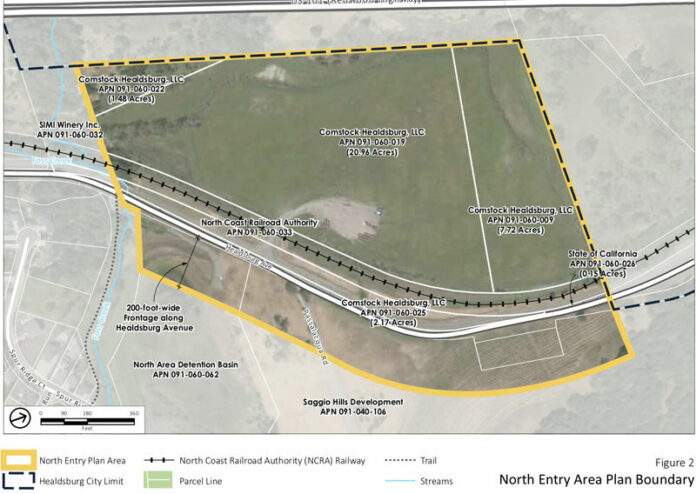Judge expected to issue final ruling in California River Watch case in about 90 days
On Feb. 6 Judge Patrick Broderick issued a tentative ruling in favor of the city of Healdsburg in the California River Watch case versus the city of Healdsburg in regard to the North Area Entry Plan (NEAP).
Healdsburg City Manager David Mickaelian said they hope to get the final ruling within the next 90 days.
In a statement about the tentative ruling, attorney for California River Watch Jerry Bernhaut, wrote, “Judge Patrick Broderick issued a tentative ruling holding that it was acceptable for a hotel developer and the city of Healdsburg to evaluate the greenhouse gas emissions resulting from the construction of a 130 room, upscale wine country hotel without giving any consideration to the thousands of tons of GHG (GreenHouse Gas) emissions which will inevitably be added to the atmosphere by vehicle miles traveled to the hotel by guests from around the world and the greater U.S.”
Bernhaut works with the Law Offices of Jack Silver, the office associated with the environmental group California River Watch.
“We look forward to receiving the court’s final ruling,” Mickaelian said.
As previously reported by the Tribune in a July 18, 2019 article, “The complaint was filed in its amended version on June 25 by California River Watch and alleges the NEAP does not conform to California Environmental Quality Act (CEQA) standards. It seeks the amendment and public recirculation of the NEAP as well at court and lawyer costs.”
The NEAP is a plan to build housing, a potential 130-room hotel and a senior living facility at the northern end of town. The Healdsburg City Council approved the plan in a 4-1 vote on May 20, 2019 with then Vice Mayor Leah Gold having the dissenting vote.
The complaint against the plan was filed in Sonoma County Superior Court against the city of Healdsburg with Comstock Properties as a real party in interest. The main part of the complaint focuses on the hotel, which is still only a possibility at this point, as council has yet to take a final vote on the hotel.
Bernhaut claims that the city did not do enough to address the environmental impacts of the hotel in the Environmental Impact Report (EIR).
“The GHG emissions associated with development, especially one that hopes for tourists from everywhere and anywhere, are important to capture and analyze in an environmental impact document before it is approved. The city did not do that. It chose a methodology that failed to capture emissions from air travel. Air travel is, of course, a very large contributor to climate change,” Bernhaut wrote in the statement.
He stated that during review of the project, River Watch asked the city to look at air travel yet the city chose not to.
When asked if the city felt that the EIR was adequate even though it did not address the GHG travel emmissions, Mickaelian wrote in a statement, “The city is confident that its EIR satisfied the requirements of CEQA and analyzed GHG emissions in a meaningful way. The EIR studied GHG travel emissions consistent with protocols accepted by the scientific community and used statewide.”
In a separate interview with Bernhaut when asked if cities typically conduct this type of travel GHG emissions analysis, he said “No.”
“We are trying to get them to do it, they (cities) do not want to include that information,” he said, noting that he was not aware of any city that has included GHG emissions from air travel in a development EIR.
“I am not aware of a city that’s included those emissions numbers in an EIR, (but) that doesn’t mean that it is not consistent with CEQA (California Environmental Quality Act) law. We are trying to get cities to take responsibility,” Bernhaut said.
Bernhaut said when River Watch successfully challenged Sonoma County’s Climate Action Plan, the judge in that case concluded that the county should have either evaluated emissions or had a feasible explanation with evidence as to why it couldn’t be done.
“The information is available if you really wanted it,” Bernhaut said.
As reported in the July Tribune article, the complaint states that the final EIR could, “calculate the proportional contribution of the increased capacity from the proposed 130-room hotel to those reasonably foreseeable VMT (vehicle miles traveled) induced emissions.”
When asked if there were GHG estimates made for guests traveling to the possible hotel, Bernhaut said estimates were made throughout the course of settlement negotiations. Bernhaut said the NEAP hotel analysis completed by expert shows the “Final accounting of yearly GHG emissions attributable to the proposed hotel” on page 82 of the report.
According to page 82 of the analysis, stand-alone air travel from arrivals and departures attributable to the proposed hotel would produce approximately 4,839.3 metric tons of carbon dioxide per year.
In terms of next steps, Bernhaut said they do not know if they would move to appeal the ruling if they are ruled against in the case.








